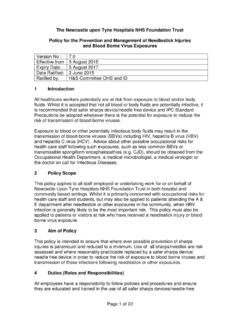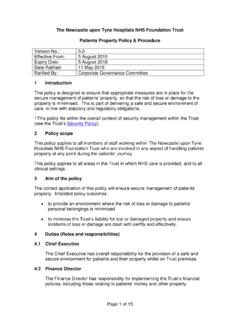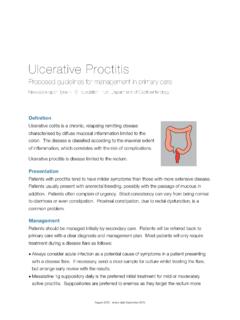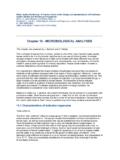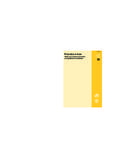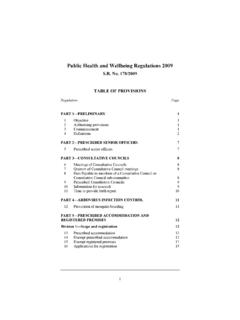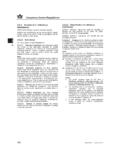Transcription of Surgical Scrub, Gown and Glove Procedure - Newcastle …
1 Page 1 of 16 The Newcastle upon Tyne Hospitals NHS Foundation Trust Surgical scrub , gown and Glove Procedure Version No.: 3 Effective From: 22 June 2017 Expiry Date: 22 June 2020 Date Ratified: 30 May 2017 Ratified By: Theatre User Groups & Clinical Policy Group 1 Introduction There is a standard Procedure for Surgical hand antisepsis, gowning and gloving which is based on current evidence, best practice and validated research. The patient s Surgical outcome is enhanced by the promotion of an aseptic environment (Association for Perioperative Practice 2011). This policy supports infection prevention and control which is a priority for the Trust.
2 2 Scope This policy is to provide guidance to all healthcare professionals required to undertake a Surgical hand scrub and the donning of a sterile gown and gloves in order to protect a patient from infection during an operation or other invasive Procedure 3 Aims The aim of the policy is to provide a standardised Procedure for Surgical hand antisepsis, donning of a sterile gown and gloves . 4 Duties Directorate Managers and unit Matrons are responsible for the policy implementation Departmental Sisters are responsible for ensuring implementation and compliance with the policy All members of the scrub team are responsible for complying with the policy 5 Definitions The scrub team includes all doctors, registered nurses, operating department practitioners, Surgical care practitioners, advanced scrub practitioners and assistant scrub practitioners who are required to carry out this scrub Procedure .
3 Scrubbing or scrub is a term used to describe the process of hand and forearm decontamination required by the Surgical team prior to commencing any Surgical or invasive Procedure . Page 2 of 16 6 The Surgical scrub , gown and Glove Procedure All members of the sterile Surgical scrub team are required to perform a Surgical hand scrub and don sterile gown and gloves before touching sterile equipment or the sterile field. The correct performance of these procedures helps to protect a patient from infection by preventing pathogenic (disease producing) micro - organisms on the hands, arms and clothes of sterile team members from coming into contact with a patients wound during an operation.
4 The resulting infection from micro - organisms introduced into a wound during surgery could prove fatal to the patient. The Surgical scrub is a systematic washing of the hands and forearms and scrubbing of finger nails using especially developed techniques and the most effective antibacterial cleansing agent available in order to render the hands and arms as free as possible from micro - organisms . The skin cannot be sterilised without destruction of tissue but as many bacteria as possible can be removed by a thorough hand and arm antisepsis to make the skin surgically clean. gown and Glove procedures that are performed following the Surgical scrub , involve the donning of a sterile Surgical gown and gloves in such a way as to maintain sterility of the outside of both gown and gloves .
5 The purpose of these procedures is to eliminate some of the controllable sources of contamination in the performance of aseptic procedures . The person assigned to scrub for an operation should adhere to these specialist techniques and must scrub their hands and arms for a prescribed length of time as described in the Procedure prior to donning a sterile gown and gloves to provide a sterile covering for their clothing and hands. Latex Use and Actions required For those staff who, following review need to use latex going forward, Departmental Managers/Leads will need to complete the occupational health referral form attached stating latex user requiring health surveillance and email to These staff will be assessed by occupational health team and placed in the appropriate health surveillance programme.
6 Please review the Health and Safety Executive information and the current Latex Policy as part of your review. http://nuth-vintranet1/apps/policies/ Hand washing is an important factor in preventing the spread of infection (refer to Trust Hand Hygiene Policy) and although the circulating person is not required to perform a Surgical scrub , they should wash their hands before and between tasks for their own protection and for that of the patient whose body defences are weakened by both the disorder that makes surgery necessary and by the surgery itself. micro - organisms Page 3 of 16 The micro - organisms normally present on the skin can be described as transient and resident: Transient organisms are those that are introduced onto the skin surface by contact with soil ( micro - organisms on surfaces) and various other substances from the environment.
7 Washing with soap solution will remove most of the bacteria. Resident organisms are those whose natural habitat is the skin. They comprise gram positive and gram negative bacteria and exist in large numbers under the fingernails, in the deeper layers of the skin such as hair follicles, sweat glands and sebaceous glands. Scrubbing removes the resident bacteria from the surface and just beneath the surface of the skin. After a time the resident organisms in the deeper layers of the skin are brought to the surface by perspiration and the oil secretion of the sebaceous glands and the bacterial count is again increased. For this reason sterile gloves are worn to prevent contamination of the patient s wound and the sterile instruments/equipment used during procedures .
8 Preparation for scrubbing Personal cleanliness is of extreme importance for operating theatre personnel. A daily shower, frequent hair washing and attention to hands and fingernails are most important. Finger nails should be kept short enough so that they are not visible over the tips of the fingers. Short nails are easy to keep clean, will not puncture gloves and should be free of any form of nail treatments or polish. Staff should note and report to the person in charge, any infection, rash or open lesion on their hands, nails or arms. It is recommended that staff use the rest room facilities before scrubbing to reduce the risk of having to leave the table once the Procedure has started.
9 Jewellery Jewellery is a hazard in theatres; wrist watches and jewellery of any kind (including dress rings and bangles) must not be worn. Wedding rings harbour bacteria so should be removed when scrubbing wherever possible. Earrings are dangerous in that they may fall into a wound and therefore must not be worn at any time (refer to Infection Control Practice in the Operating Department policy). All staff should adhere to bare below the elbows prior to any form of clinical contact with patients. Clothing All operating theatre staff should wear a clean, short sleeved cotton scrub suit each day before entering the operating department.
10 The scrub suit should cover any other clothing such as underwear, and trouser legs should not touch the floor as this may transport bacteria from one place to another. The person assigned to scrub should also adjust the sleeves of their scrub suit to Page 4 of 16 at least four inches above the elbows to prevent them from getting wet and potentially increasing the risk of contamination of the gown . Footwear Dedicated personalised closed toe non-slip footwear must be available for all regular theatre staff in the theatre complex. Boots should be worn if there is a high risk of heavy blood/body fluid loss. Observers to theatre Procedure within the operating theatre must be provided with spare theatre shoes.




